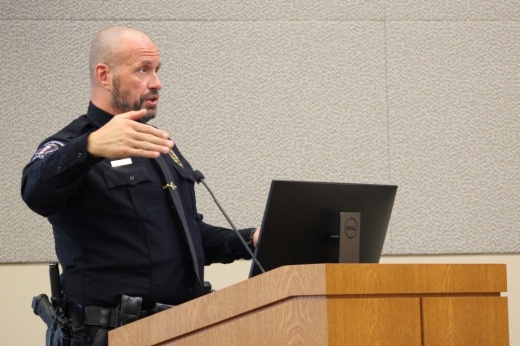Georgetown Police Chief Cory Tchida presented an update to City Council members on these statistics and more during a Feb. 11 city workshop.
After seeing an increase in active attacks outdoors such as the New Year’s Day attack in New Orleans, Tchida said he hopes his department will be the standard when it comes to responding to attacks and mitigating threats.
“My goal for the Georgetown Police Department is that our vision is to be the standard,” Tchida said. “We are absolutely going to be the standard when it comes to the active attack domain, and we will utilize every amount of training and every resource to mitigate these threats that they hopefully never happen.”
Calls for service
In 2024, patrol officers responded to 28,867 calls for service—or instances of the public requesting assistance from the police department—Tchida said. That number is the highest in over a decade, up by 47% since 2014, according to city documents.“With the designation—the third in a row—[as] the fastest growing city in the country, it is reasonable to expect calls for service to go up,” Tchida said. “The calls are increasing, but they are certainly not increasing in line with the population growth.”
The most common call for service in 2024 was 911 hangup abuse, or accidental phone calls, Tchida said.
“That's just a product of the technological generation where everybody's phones and watches and cars are calling us every time it thinks something bad happens,” he said.Traffic
Motor vehicle crashes have increased by 91% in the past decade, according to city documents.“This one's tough. We continue to see really stark increases in motor vehicle crashes in the city,” Tchida said. “Geographically, we're a really big city, and there's a lot of people coming through this city.”
A common location for stop-and-go crashes is in front of Wolf Ranch, a growing subdivision near I-35 and Hwy. 29, he said.
Tchida said he doesn’t believe the department receives accurate self reporting when investigating crashes because people hesitate to admit to using their phones during the time of the crash.
During COVID-19, the police department urged officers to avoid making traffic stops unless a serious situation came up to avoid putting officers and citizens at risk, Tchida said. This caused a significant dip in 2019. Now, traffic stops are up since 2023, but not as high as they were in 2017.Crime
Reports and arrests are up slightly since 2023, with over 7,000 reports and roughly 1,500 arrests made in 2024, according to city documents.
“Arrests aren't that big of a metric for me, because that's not an indicator of success,” Tchida said.
Georgetown tends to average around 1,000 Part 1 crimes, which include murder, rape, robbery, aggravated assault, burglary, motor vehicle theft and larceny, per year, Tchida said.“We stayed on track with a slight increase from last year, but not as much as we saw in 2020,” he said.
Tchida said 77% of total crime in 2024 was property crimes, specifically larceny, motor vehicle theft and burglary, while 15% of total crime was burglary of a vehicle.
Tchida said the department has been working on better ways to reach residents on the importance of locking vehicles. Throughout their research, officials have found people’s behavior is location-dependent.
“You might go to Wolf Ranch and go shopping, and there's no universe in which you would dream of leaving your car unlocked,” Tchida said. “But you park your car in your driveway at home, and you don't think twice about leaving it unlocked.”
Tchida said the department will continue looking at creative ways to convince people to do something they already know they should be doing.
Homelessness
The police department and the Crisis Intervention Team made 1,127 homeless contacts in 2024, but the number could include multiple contacts with the same person, Tchida said.Additionally, the department tracked about 90 homeless camps throughout Georgetown, with a higher concentration existing downtown, along major arterial roadways, on natural waterways, and near hike and bike trails, Tchida said.
The department works hard to respond to reported homeless camps to quickly mitigate the situation, Tchida said, emphasizing how the nature of the camps can be “terrible” for people living there.
“We've had some of them that are very close to hazardous material sites,” Tchida said. “There's always an opportunity for people to be victimized in these camps.”
Homeless camps on private property must ultimately be handled by the property owner, he said. District 5 council member Kevin Pitts asked Tchida to look into where contacts with people experiencing homelessness occur to see if there are trends.
“One of the things I've always talked about is [working] really hard to understand and honor the humanity—that these folks we’re dealing with are people,” Tchida said. “But I also understand that even sometimes for their own well-being, enforcement is necessary.”Out of the 58 criminal trespassing arrests the police department made in 2024, about 47 of them were committed by people who are likely experiencing homelessness or are unhoused, Tchida said.
Tchida’s team is trying to target a rise in panhandling by enforcing violations when people fail to use a sidewalk.
“It's never been about the panhandling, it's about people in the roadway,” Tchida said. “People and cars do not mix.”
Mental health
Mental health calls are also steadily increasing in Georgetown. Tchida said out of the 1,574 mental health calls for service last year, 26% of them came from individuals or staff requesting assistance at two of the city’s mental health hospitals—Rock Springs and Georgetown Behavioral Health Institute.Often, police officers would not realize a call for service was a mental health crisis situation until they arrived at the scene, Tchida said.
In 2024, there were 229 emergency detentions, or brief detainments of people experiencing a mental health crisis to allow for a professional to evaluate them. Last year, about 37 of them were from people experiencing homelessness, per city documents.
Individuals needing emergency detentions are almost equally split between men and women, but the majority of individuals receiving them are white, and the average age is 37, Tchida said.
“In the state of Texas, the only one that has the authority to do a mental health detention is law enforcement,” Tchida said. “An emergency detention is ... insanely time consuming.”
House Bill 1538 is pending in the 89th legislative session. Tchida said it could expand who can facilitate emergency detentions, but additional help doesn’t make the enforcement go by any faster.
“A paramedic and an ambulance tied up doing one of these for several hours is probably not the win we're looking for,” Tchida said.
He said police staff were hoping a medical professional would be allowed to start doing emergency detentions. Tchida said having a doctor stationed at a mental health facility where the patient might already be would mean GPD doesn’t need to arrive at the facility to do the detention themselves.
Going forward
In 2025, Tchida said the department is looking to improve:
- Policy and oversight
- Technology usage, like license plate readers
- Social media
- Training and education
- Officer wellness and safety
- Supporting officers’ families
- Hiring quality staff and improving retention rates
- Community policing and crime reduction
- Building trust and legitimacy
Tchida agrees.
“I am deeply concerned about our senior population in the city that fall victim to [cybersecurity attacks]. I am equally concerned about our kids,” Tchida said. “If you are not paying attention to what your kids are doing online, you have got to start.”





